If you want to know how to identify the type of goldfish you have, you just need to look at its features. In this overview I’ll help explain what unique features you can look for in order to identify your goldfish. There are hundreds of goldfish types, many that have been crossbred, so it is just good to note that this list is not exhaustive. However, most the goldfish you can readily find should be on this list.
List of Goldfish
- American Shubunkins
- Bristol Shubunkins
- Bubble Eye
- Butterfly Tail
- Celestial Eye
- Comet
- Common
- Curled-gill
- Eggfish
- Fantail
- Imperial
- Izumo Nankin
- Jikin
- Lionchu
- Lionhead
- London Shubunkins
- Moor
- Nymph
- Oranda
- Panda Telescope
- Pearlscale
- Pompon
- Ranchu
- Red Cap Oranda
- Ryukin
- Sabao
- Shukin
- Tamasaba
- Telescope
- Tosakin
- Veiltail
- Wakin
- Watona
My Recommendations
I believe hardy goldfish breeds are best for beginners and for outdoor ponds. I would try not to make mistakes but if you do, the hardy types have the best chance of surviving compared to the fancy breeds.
With respect to fancy breeds, I know you will be able to find some of the fancy breeds at your local pet stores but some of the less familiar ones are likely only available through breeders. For those with some experience, the resources for a proper setup, and a willingness to keep up on the maintenance, you can be successful with a fancy goldfish.
One word of warning for you all. I hope you do not but if you give up on your goldfish, please do not release them into the wild. Goldfish are invasive and will often outcompete the native fish in your local lakes, and waterways. I wish I knew this information when I was younger.
Tim
Hardy Goldfish Types
A body shape that has an elongated flattened football shape include: The Common, the Comet, Shubunkin. (good breeds for an outdoor goldfish pond).The common, comet and shubunkin look very similar in shape and colors.
- The comet has longer fins and most notably its tail fin is much longer.
- The common doesn’t come in calico but the comet and shubunkin do.
- The shubunkin is only calico so if it’s calico with short fins, it can’t be a common.
Common vs Comet vs Shubunkin Goldfish
| Goldfish Breed | Body Type | Dorsal Fin | Tail Shape | Coloration | Origin | Care Difficulty |
|---|---|---|---|---|---|---|
| Common | Long and slender | Present | Single tail | Various shades of gold | China | Easy |
| Comet | Streamlined, robust | Present | Forked tail | Metallic orange | USA | Easy |
| Shubunkin | Streamlined, robust | Present | Forked tail | Calico pattern of blue, orange, and black | Japan | Easy |
Fancy Goldfish Types
An egg shape body shape are considered the fancy breeds and can include: Fantail, Ryukin, Veiltail, Oranda, Telescope, Black Moor, Panda Butterfly, Ranchu, lionhead, Pompon, Pearlscale, Hama Nishki, Celestial and Bubble-Eye. The mature oranda, ranchu and lionhead has a wart like wen hood cover over its face and head.
- The oranda has a dorsal fin and the lionhead and most ranchu don’t.
- The ranchu has a prominent arch in its back and downward pointed tail fins.
- The lionhead and oranda have a straighter back line.
- A goldfish with a hood cover with a straight back and no dorsal fin is a lionhead.
- The fantail, ryukin and veiltail have similar egg-shaped bodies with no distinct features like a hood cover or globe eyes
- The fantail and ryukin have sturdy upright fins and tails.
- The ryukin has a more prominent hump that the dorsal fin sits on than the fantail.
- The veiltail has long flowing fins and tail.
- The telescope, black moor and panda butterfly have their eyes on the sides of ball like protuberances
- A black moor is a telescope/globe-eye but is only black or faded black in color.
- The panda butterfly resembles the colors of a panda bear, clear sections of black and white.
- The pearlscale and hama nishiki have a golf ball body shape with scales that stand out like little white domes
- The hama nishiki has a slight hood cover on top of its head while the pearlscale does not.
- The celestial has bulging eyes that point upward and no dorsal fin.The bubble eye has two bubble shaped check pouches
Oranda vs Ranchu vs Lionhead Goldfish
| Goldfish Type | Body Type | Dorsal Fin | Headgrowth | Origin | Care Difficulty |
|---|---|---|---|---|---|
| Ranchu | Round, compact | Absent | Top of head | Japan | Moderate |
| Lionhead | Round, compact | Absent | Top of head and under chin | China | Moderate |
| Oranda | Round, compact | Present | Top of head | China | Moderate |
Ryukin vs Oranda
| Goldfish Type | Body Type | Dorsal Fin | Headgrowth | Tail Shape | Origin | Care Difficulty |
|---|---|---|---|---|---|---|
| Oranda | Round, compact | Present | On top of head | Short and rounded | China | Moderate |
| Ryukin | Short, deep body | Absent | No headgrowth | Short and deeply forked | Japan | Moderate |
Ryukin vs Fantail Goldfish
| Goldfish Type | Body Type | Dorsal Fin | Headgrowth | Tail Shape | Origin | Care Difficulty |
|---|---|---|---|---|---|---|
| Ryukin | Elongated and deep body | Short and stiff, may lay flat or have a slight curve | No headgrowth | High arching and pointed | Japan | Moderate |
| Fantail | Short and stocky body | Short and erect | No headgrowth | Split, resembling a fan | Developed from China | Easy |
The reason there are so many types of goldfish breeds is due to years of selective breeding.
The Common Goldfish
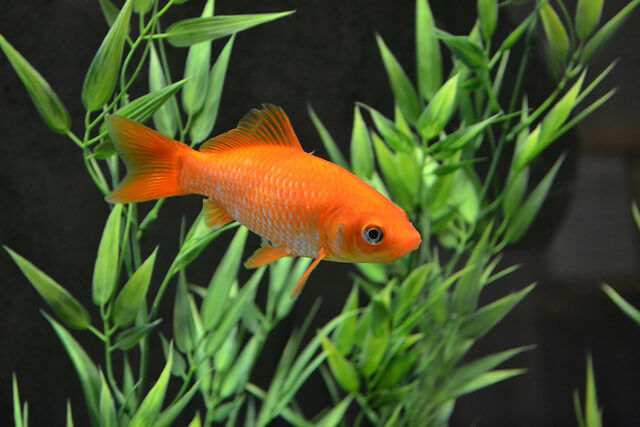

Common goldfish is a hardy breed and an excellent choice for beginners. They can survive in temperatures ranging from 55-80°F (12-26°C), and a pH of 6-8, which is similar to tap water. They don’t require a heater and minimal care if kept in a well-filtered 10-gallon aquarium. In the wild, common goldfish can be found in freshwater, lakes, rivers, canals, and even ditches that have adequate vegetation. They prefer cooler water temperatures around the low 70s (21s°C).
Learn more about common goldfish care
You might also be interested in knowing what the difference between a goldfish and a koi is.
Comet
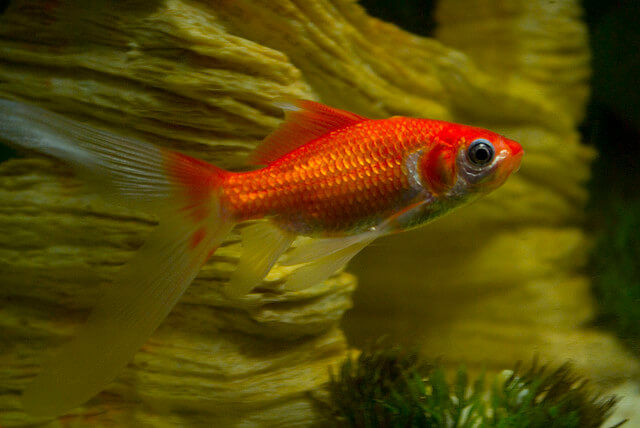

When keeping Comet Goldfish, they require a minimum of a 55-gallon (208 liter) tank or pond as they grow up to 12 inches long (30.48cm). Additionally, they need a well-maintained filtration system and regular water changes to maintain good water quality. Comet Goldfish are omnivorous and will eat both plant and animal matter, but it’s essential to feed them a varied diet that includes high-quality fish food, vegetables, and live or frozen food.
Learn more about comet goldfish care
Shubunkin
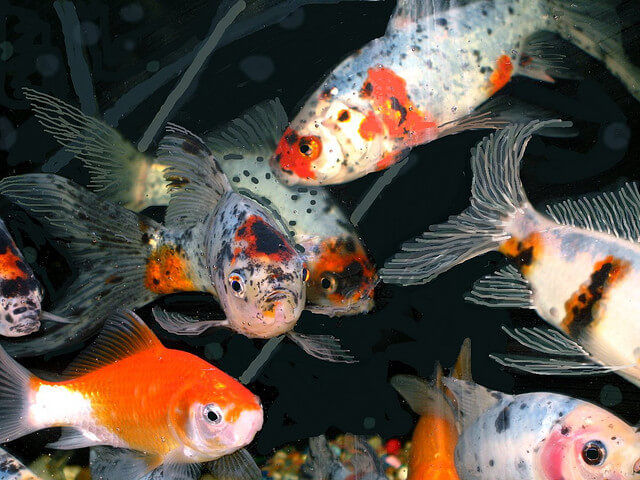

The shubunkin goldfish is a stunning breed that combines the body shape of common or comet goldfish with the vibrant colors of fancy goldfish types. There are two varieties of shubunkin goldfish: the London shubunkin and the Bristol shubunkin. The Bristol shubunkin is larger and has a more rounded caudal fin compared to the London shubunkin.
Learn more about shubunkin goldfish care
Wakin
The wakin goldfish is a beloved and popular breed in Japan, thought to be the common goldfish of East Asia. With its elongated body and double caudal tail fin, it closely resembles the comet goldfish, but with a shorter, fantail-like tail. It is one of only two goldfish breeds, along with the jikin goldfish, to have this unique combination of elongated body and double anal and caudal fins.
Learn more about wakin goldfish care
Japanese Ryukin
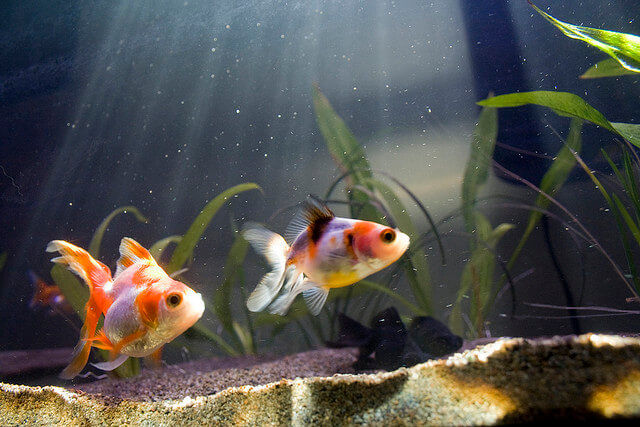

The Japanese Ryukin goldfish is a unique breed that is highly sought after by goldfish enthusiasts. Originating from the Ryukyu Islands, this goldfish has a distinct appearance that sets it apart from other goldfish types. It resembles the fantail goldfish in body shape, but what makes it unique is the prominent hump on its back that elevates the dorsal fin. Additionally, the long caudal tail fins can have three or four lobes, giving it a stunning cherry blossom petal tail.
Learn more about Ryukin goldfish care
Care Guides
Fancy Fantail
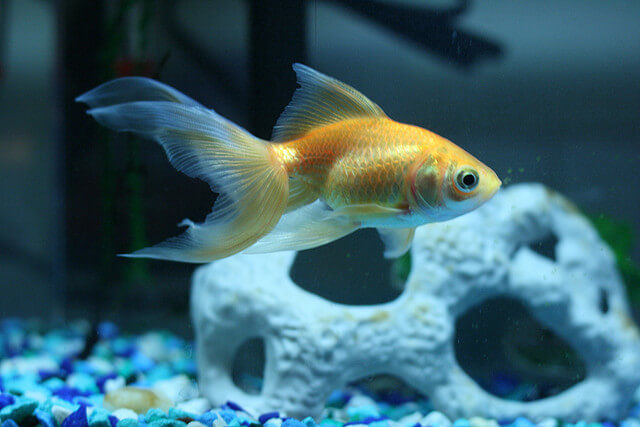

The Fancy Fantail goldfish is a popular and well-known variety of fancy goldfish. It is easily distinguished from other goldfish breeds by its egg-shaped body that makes up about three-fifths of its overall length. The Fantail Goldfish has a single dorsal fin, but all other fins are paired, including the caudal fin which is split down the middle with a forked appearance on each fin. The fins are sturdy and rounded at the end, resembling blades of a fan. This is most noticeable when viewing the caudal tail fin from directly above.
Learn more about fancy Fantail goldfish care
Veiltail
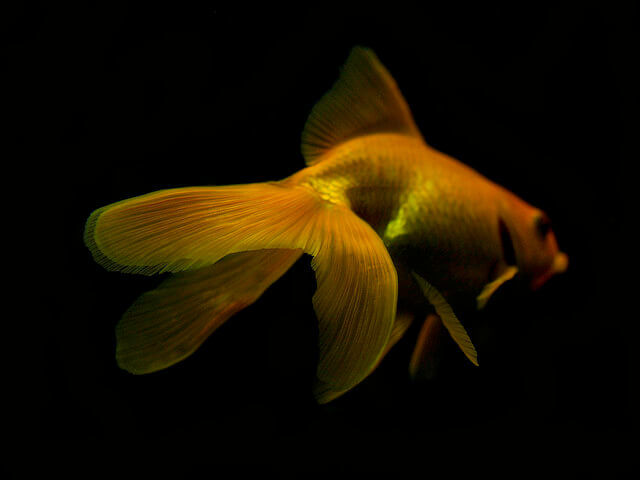

The veiltail goldfish is a popular type of goldfish among collectors and hobbyists, but it is a variety that is difficult to breed for showing. Its long, flowing, paired caudal tail is the veiltail’s most prominent feature. The caudal tail fins should not be forked or have pointed tips but be completely divided when viewed from above. When your veiltail goldfish swims, the caudal tail fins should flow elegantly in the water. Its dorsal fin should not fold over or sag but rather sway like a flag in the wind. The pectoral and pelvic fins should be long and narrow.
Learn more about veiltail goldfish care
Globe Eye or Telescope
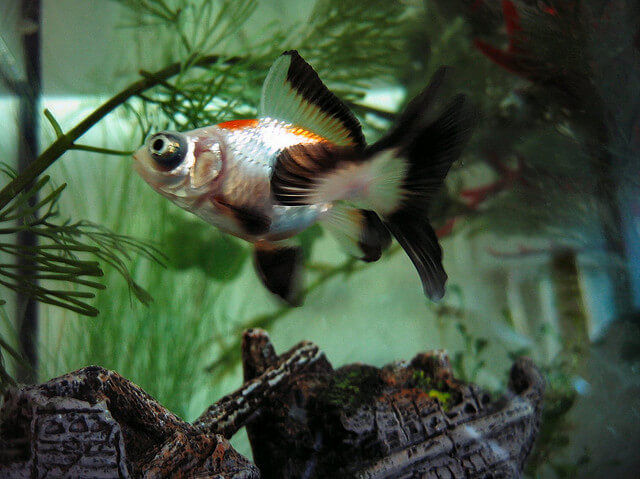

The Telescope Goldfish, also known as the Globe Eye Goldfish or Dragon Fish in the Far East, is a fancy goldfish type that is easy to recognize due to its protruding eyes. These eyes start to develop around six months of age and are located on the outermost tip of its globe-shaped protuberance. The body of the Telescope Goldfish is similar to that of the Veiltail Goldfish, with a short, deep, rounded body.
Learn more about telescope goldfish care
Broadtail Moor
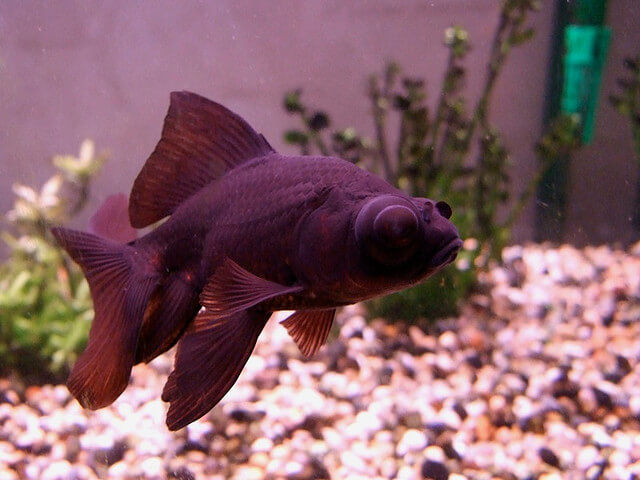

The Broadtail Moor goldfish, also known as the Black Moor, is a fancy goldfish type that is entirely black in color, although some specimens may contain shades of brown or silver. Show quality Black Moors have a flat sooty color. The Black Moor closely resembles the Veiltail Goldfish, with a single dorsal fin located high on its back, and all other fins paired. Its paired and flowing caudal fin should be fully divided with rounded tips and an absence of a forked appearance. However, unlike Veiltail Goldfish, the Black Moor has protruding eyes that resemble the Telescope Goldfish, with its eyes placed on the extreme tips of its protuberances.
Learn more about broadtail black moor goldfish care
Oranda
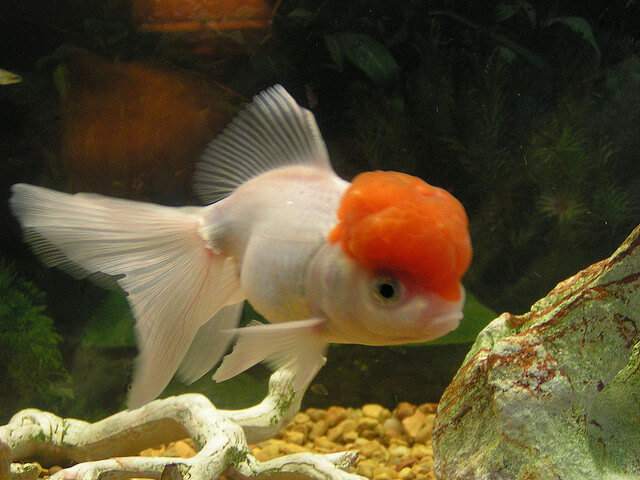

One of the most recognizable features of the Oranda Goldfish is the soft, wart-like hood cover that develops as they mature. These hoods form around the head and face, adding to the fish’s allure. However, it’s important to note that the development of hoods varies among individuals. Some Oranda Goldfish will develop substantial hoods, characterized by lumps of similar size that extend from the head to the gills. Others may have more modest hood growth, while a few individuals may not develop hoods at all. The variation in hood development contributes to the unique and diverse appearances of different Oranda specimens.
Learn more about Oranda goldfish care
Pearlscale
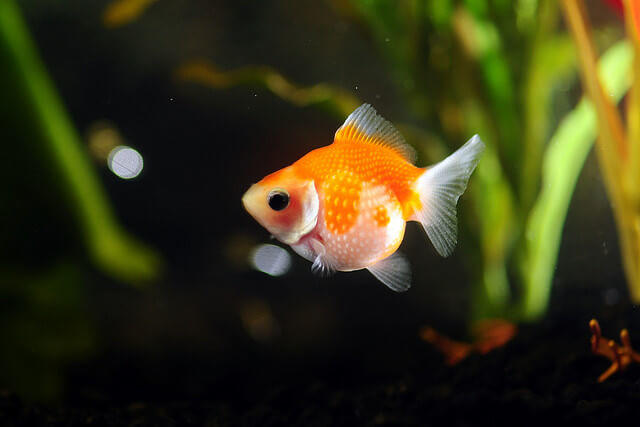

The pearlscale goldfish has a distinctive spherical body shape and dome-like scales made of calcium carbonate, resembling a golf ball. Its small pointed head contains a little mouth that doesn’t stand out, making the body more noticeable. The single dorsal fin starts at the middle of the back and extends all the way to the caudal peduncle, while all other fins are paired with rounded ends. The sturdy caudal fins should be divided with mildly forked lobes that sit high and don’t drop down as the goldfish swims. Pearlscale goldfish come in a range of colors including metallic self-colored, variegated, and calico. They can live in an outdoor goldfish pond but are best suited for aquariums to showcase their unique features.
Learn more about pearlscale goldfish care
Hama Nishiki Goldfish
A cross bred between the pearlscale and the oranda. This goldfish bred looks a lot like the pearlscale, but its fins are slightly longer, and it has a small wen hood cover on top of its face that it gets from the oranda. It also grows slightly larger than the pearlscale.
Ranchu
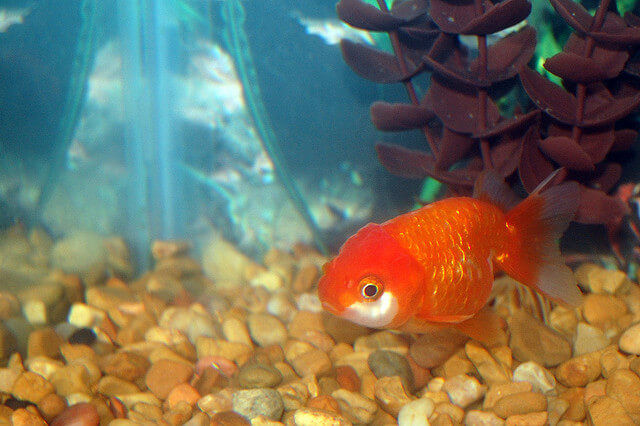

The ranchu goldfish is a full-bodied fancy goldfish with a distinct appearance. One of the most obvious features of a ranchu is the absence of a dorsal fin. A show-quality specimen should have a clean, arched back with no sign of a dorsal fin. The back of the ranchu should have a pronounced upward arch, curving sharply downwards at the peduncle and caudal fins. This curve directs the pair of divided caudal fins downwards, and the optimal angle of the back curve and the direction of the upper lobes of the caudal fins should be 90 degrees.
Learn more about ranchu goldfish care
Pompom
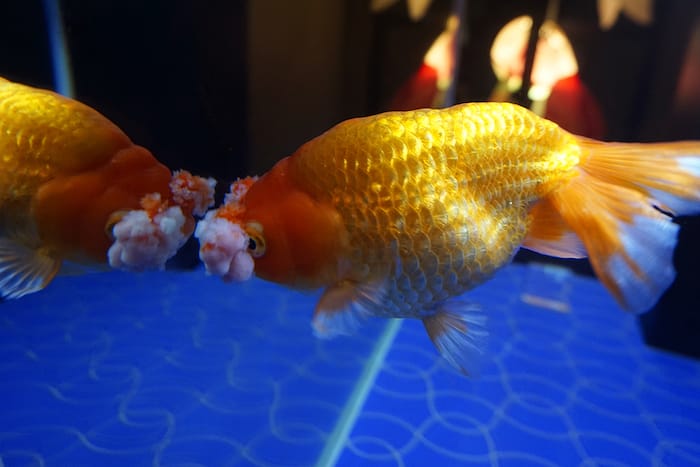

The pompom goldfish is a fancy goldfish breed named after its fleshy lobed nasal septa that resemble pompons. These growths are connected to the goldfish’s nasal septum and act as sensors for smelling airborne chemicals and odors. The body of a true pompon goldfish should look like the body of ranchu types without a dorsal fin. They come in metallic and calico colors. A quality pompon specimen should have a solid uniform growth and be spherical in shape, with the pompon lobes not hanging down into the mouth. They are best suited for goldfish aquariums with water no colder than 55*F (12.8°C) and should not be placed in an outdoor pond. Tank mates should only include other delicate and slow-moving breeds like the telescope, oranda, bubble eye, or celestial.
Learn more about pompom goldfish care
Bubble Eye
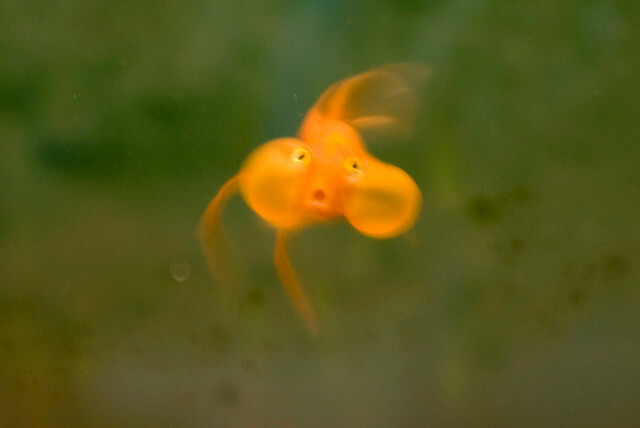

The bubble eye goldfish is a fancy goldfish breed that is characterized by its fluid-filled sacs or pouches that protrude from its cheeks. These pouches, which are filled with water or air, give the bubble eye goldfish its distinctive appearance. The pouches are delicate and require careful attention to avoid damage. The goldfish’s eyes are upward-pointing, similar to the celestial, and the body shape and fins are also similar. A high-quality bubble eye goldfish will have two equally developed pouches that sit right below its eyes. The colors of the bubble eye goldfish include metallic self-colored, variegated, and calico.
Learn more about bubble eye goldfish care
Celestial
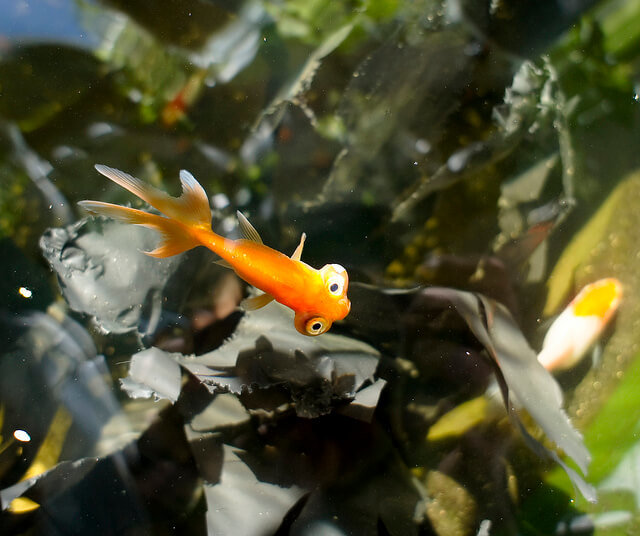

The celestial goldfish is a small and delicate fancy breed of goldfish that requires special care to ensure its health, making it not suitable for beginner goldfish hobbyists. One of the most unique features of the celestial goldfish is its protruding eyes that are always set to face upwards. This feature means that the celestial goldfish should not be kept in a tank with any decoration that can scrape or poke its eyes. The tank should also not have a bright light since the celestial goldfish is always looking up while at rest.
Learn more about celestial goldfish care
Complete Goldfish Comparison Chart
| Goldfish Breed | Body Type | Dorsal Fin | Headgrowth | Tail Shape | Origin | Care Difficulty |
|---|---|---|---|---|---|---|
| American Shubunkins | Streamlined, slender | Present | No headgrowth | Forked | USA | Easy |
| Bristol Shubunkins | Streamlined, slender | Present | No headgrowth | Forked | UK | Easy |
| Bubble Eye | Elongated, round | Absent | None | Short and rounded | China | Moderate |
| Butterfly Tail | Elongated, slender | Present | None | Butterfly | Japan | Moderate |
| Celestial Eye | Elongated, round | Absent | None | Short and rounded | China | Moderate |
| Comet | Streamlined, slender | Absent | No headgrowth | Forked | USA | Easy |
| Common | Streamlined, slender | Absent | No headgrowth | Forked | Asia | Easy |
| Curled-gill | Streamlined, slender | Present | None | Forked | Asia | Moderate |
| Eggfish | Rounded, egg-shaped | Absent | No headgrowth | Short and rounded | China | Easy |
| Fantail | Rounded, egg-shaped | Absent | No headgrowth | Short and rounded | China | Easy |
| Imperial | Rounded, egg-shaped | Absent | No headgrowth | Short and rounded | China | Easy |
| Izumo Nankin | Rounded, egg-shaped | Absent | No headgrowth | Short and rounded | Japan | Moderate |
| Jikin | Streamlined, slender | Present | None | Butterfly | Japan | Moderate |
| Lionchu | Rounded, egg-shaped | Present | On top of head | Short and rounded | USA | Moderate |
| Lionhead | Rounded, egg-shaped | Absent | On top of head | Short and rounded | China | Moderate |
| London Shubunkins | Streamlined, slender | Present | No headgrowth | Forked | UK | Easy |
| Moor | Rounded, egg-shaped | Absent | No headgrowth | Short and rounded | China | Easy |
| Nymph | Elongated, slender | Absent | None | Butterfly | Japan | Moderate |
| Oranda | Round, compact | Present | On top of head | Short and rounded | China | Moderate |
| Panda Telescope | Elongated, round | Absent | None | Short and rounded | China | Moderate |
| Pearlscale | Rounded, egg-shaped | Absent | No headgrowth | Short and rounded | China | Moderate |
| Pompon | Rounded, egg-shaped | Absent | No headgrowth | Short and rounded | Japan | Easy |
| Ranchu | Round, compact | Absent | On top of head | Short and rounded | Japan | Moderate |
| Red Cap Oranda | Round, compact | Present | On top of head | Short and rounded | China | Moderate |
| Ryukin | Short, deep body | Absent | No headgrowth | Short and deeply forked | Japan | Moderate |
| Sabao | Elongated, slender | Absent | None | Butterfly | Japan | Moderate |
| Shukin | Short, deep body | Absent | No headgrowth | Short and deeply forked | Japan | Moderate |
| Tamasaba | Elongated, slender | Absent | None | Butterfly | Japan | Moderate |
| Telescope | Elongated, round | Absent | None | Short and rounded | China | Moderate |
| Tosakin | Elongated, round | Absent | None | Butterfly | Japan | Difficult |
| Veiltail | Streamlined, slender | Absent | No headgrowth | Long and flowing | USA | Easy |
| Wakin | Streamlined, slender | Absent | No headgrowth | Forked | Japan | Easy |
| Watona | Streamlined, slender | Absent | No headgrowth | Forked | Japan | Easy |
Article Citations and Resources
- Johnson, Erik DR., and Richard Hess. Fancy Goldfish: Complete Guide To Care And Collecting. Weatherhill, 2001.
- Boruchowitz, David. Aquarium Care of Goldfish. T.F.H Publication, 2008.
- Brewster, Bernice. An Essential Guide to Keeping Goldfish. Interpet Publishing, 2003.
- Halls, Steve. Your Healthy Garden Pond. Howell Book House, 2000.
- Sweeney, Mary. The 101 Best Aquarium Plants. T.F.H, 2008.
- Watson, Craig A., et al. “Species Profile: Koi and Goldfish.” SRAC Publication No. 7201, Southern Regional Aquaculture Center, September 2004.
Photo credits: biodork , 8113246@N02, sheffield_tiger, stwbrypocky, norman_baboo, cliche, peterrosbjerg, astrid-goes-usa/, kerjsi, amymyou, hand-nor-glove, 10349297@N00, angiehu
Reviewed By: Tim Winter


Tim Winter has a strong affection for pets and wildlife. His years of experience caring for various types of pets has led him to share his knowledge with others on the best practices in pet care. Tim holds a Bachelor of Science from the University of Oregon School of Journalism and Communications.



How many fish can I put in a 21.5 across , 36.5 width and 25.7 tall tank( I have guppies and shrimps)*・゜゚・*:.。..。.:*・'(*゚▽゚*)’・*:.。. .。.:*・゜゚・*
I’m not so sure what type of goldfish I have ,so please can someone help me?we have two fish that are oval shaped, with orange skin and scales, and has like a type of black dots that looks like a smiling face if you look sidwards.
Thanks for your help,
Amy
can you tell more type of fishes?
What type of goldfish has an elephant type nose
What type of goldfish has an elephant type nose
I have a black and gold goldfish and it has a beautiful black fantail very rare I can find a example , what species is this.
I have a telescopes goldfish that was sold as a butterfly goldfish, his tail only has three fins ,is this a true butterfly .His tail looks nothing like the others.
can Oranda goldfish be put together in an inside aquarium to keep together.
The answer is a resounding YES. Just make sure you have a large enough tank for them. If you want to grow them out some in a smaller tank that’s ok(they kinda look lost in a big tank and is what I do). MAKE SURE YOU HAVE A TANK THAT’S A MINIMUM OF 55 GALLONS WAITING for when they start to out grow their tank. The idea that a fish will only grow as large as it’s tank is FALSE.
Remember that Oranda’s can get larger than the average female hand not including the fins. Try to get a filter that’s at least twice (min) recommended for you goldfish. (i recommend it for any tank actually)
as goldfish produce a lot of waste. They like nibbling on greens so toss some common floating plants in for nibbles.
BE SURE TO HAVE A HEATER. Ones that are completly submersible and stick to the side of your tank are best.(you may need morw than one depending on what your store offers but it’s worth it). Partial water changes are vital.
Yes, they can be a pain in the but to care for properly but so are other fish. Enjoy them! Love them! And you will have them for many many years.They are a very personable fish. (at least mine are). Good luck and may you be rewarded with their beauty for many, many years!
How likely is it to have a solid white common gold fish? How can I purchase one?
If you are looking for just a common comet you can go to the pet store and look at their “feeder” tank. When requesting a certain colour most will oblige. They shouldn’t cost more than 25 to 50 cents each. I recommend buying at least two so they have company.
Please tell me they’re not going a bowl but something like a 10 gallon tank. Enjoy you fish!
It is very good website I like it very much I can know more about goldfish
what of water does a black moor and the white and orange have to be in
hi I have and black moor and a white and orange fish and they are just laying there but they are still moving
Check the pH levels in the tank. My two goldfish thrive in a 7.6 ph level but I’ve noticed some goldfish like other levels. Nothing more or less than a 6-8 though. If you also don’t have oxygen and a filter in the tank they can be suffering from excess ammonia in the tank. Stress can be a factor as well in fish, so if the tank is too small (20 gallons minimum for one fancy + 10 gallons for another fish) it could be causing stress for them as well. Flake food is bad but I’ve noticed if you put it in the filter stream they will have fun chasing the food around the tank! I recommend pellet food and feeding them at least a green pea once a week so it prevents dropsy. Goldfish have their intestines all scrunched up in their chubby bodies! So sometimes if some air or too much food gets stuck up in there, they can’t control themselves on their swimming features. Just make sure your goldfish are healthy and do your research!
Do you have to have a male goldfish if you only have one female goldfish that’s pregnant? I found out earlier that my one female goldfish is pregnant. Do I need to get a male goldfish?
Only if you want babies. They may be eaten by the parents as eggs or small fry so that may not be a problem for you. I do recommend however that she be given a companion of either sex
Hello I have a fish calico Japanese ryunkin fantail with 2 balls on his shoulders behind his gill covers x after keeping fish for 50 yrs I have never seen anything like x
Man o man! You just described one of my fish sold to me as a fantail! I thought it has tumors. Glad to hear that’s normal.
does my goldfish breed when if the male is bigger than the female
I have a comet and a moor unforunately my moor died today and now my comet is just sitting at a corner , is there any fish you can suggest i can put in tank with my comet so that my comet can pair with it. My existing comet is a male.
Pretty much any goldfish of similar size should do.
Well, it usually isn’t a good idea for comets and moors to be together, but you made it work I guess. Don’t attempt it again though.
You could pair him with any GOLDFISH of similar size and speed. Speed is important because the fast fish always get all the food first, making the slow fish starve. Goldfish are only compatible with goldfish though so only get another goldfish, but make sure it’s fast, of similar size, and has no delicate body parts like a celestial, moor or bubbleeye.
There you go, Omar. Good luck 🙂
I have had different varieties of fancy goldfish with many different varieties of cory cats for about 17 years. I have never had a problem with large fancy goldfish picking on my cory cats regardless of the huge difference in size. I never knew I could combine fancy goldfish with cory cats until an aquarium store employee told me that I was able to do that. I love having the variety.
My comet goldfish is attacking my black moor, I unfortunately had to take him out and put him in a bucket. They are predators and should not be with black moors!!! He is trying to kill my poor gold fish! 🙁
I have a black moor and a comet living together currently. They’ve been doing well for 3 months now and both seem very happy. There has been no sign of fighting or illnesses for me.
How do you no fish are male and female?
I have a comet goldfish (Ori) and a black moor goldfish(Rexi) living together for about 2-3 months now. I don’t know which one is male or female, but I suggest checking the pH level in your water. Make sure the tank is 10 gallons and above because they both can get pretty big. Have a lot of decorations (but not too much) like gravel, plants, a little house, a live plant, etc. Make sure that your fish/fishes don’t have an illness too. Hope I helped! 😀
Fish can and do get depressed when losuming a tankmate especially if they have been together for a long time.
It doesn’t matter what sex you get but I would definatly get him a new tank mate or 3. (it’been my experience that they do better in even numbers so after the adjustment period obe is not left left out of the group).
I’m very sorry to hear you lost one of your babies today. 🙁
my goldfish has stayed on the bottom of my tank for 8 hours what does this mean
hmm, any other symptoms? im only 20 but i love goldfish. i might know its issue. is it laying at a angle? or gasp for air? also do you know the species? if its a fancy or fantail it could have bladder issues or may be bloated. if not it might be nitrate poisoning. all you need to do is change 3/4ths the water is balance in the tank once every seven days till the bacterial cycle and nitrate cycle is balanced again. if its swim bladder, try feeding the fish skinless freeze dried peas. hope this helps.
hmm, any other symptoms? im only 20 but i love goldfish. i might know its issue. is it laying at a angle? or gasp for air? also do you know the species? if its a fancy or fantail it could have bladder issues or may be bloated. if not it might be nitrate poisoning. all you need to do is change 3/4ths the water is balance in the tank once every seven days till the bacterial cycle and nitrate cycle is balanced again. if its swim bladder, try feeding the fish skinless freeze dried peas. hope this helps.
its dead
sometimes the stress of another fish dying in the tank can actually cause the other fish to get sick or die too, its like they put off some sort of energy waves when a fish is ill or dying and it can be contagious to other fish in the same tank
that happened to me
means it likes the bottom
Goldfish are sometimes known to have a rest period at the bottom of the tank usually because of stress, weariness, or irregular feeding, but it is nothing serious usually.. It’s not dead though as your fish will float belly up when dead.. Sometimes fish will go to the bottom when injured, but be patient and monitor the fish’s behavior carefully.. I have two goldfish of my own in a tank with a divider, and they each often go to the bottom for a few hours once every 24 hours or so.. if that is the case then your fish is probably resting which is normal.. So I wouldn’t worry if I were you..
Mine would do this before a storm even though they were inside.
My black moor is doing that too since I removed the comet goldfish. The comet is trying to kill him so I had to remove him and put him in a plastic bucket. Sad!
I have 1 black moor fish and I want to know if I can get other fish to go in the tank with him? What other breeds of fish can I put in the tank with him?
Take a look at our post on tank mates. This should help answer your question
I have 30 commons in a 300 gallon pond that gets rain water flushed every time it rains. They love it. They swim in a school extremely fast.
Hi I have a big common goldfish and 2 gold fantails in the same tank ,the big gold fish keeps chasing the bigger of the fantails and pins it to the side of the glass or on the bottom of the fish tank,should I take the big goldfish out of the tank.
how to know the output of the goldfish , can you give us some infos. like if the parents are oranda (female) ryukin (male)
If they are different breeds of goldfish, they are very unlikely to breed. Common goldfish only breed with common goldfish because they are already a different species and cannot mate with other goldfish species. You will not get an output at all; best to try to breed one species or the other.
It has white spots an it’s gills and it was fat if it is going to breed
What are symptoms of a pregnant goldfish answer plz
It is usually chunky on one side and often looks asymmetrical, and when the “pregnancy” is about to end (for it is not a pregnancy but a storage of eggs of that which do not hatch immediately and live), males will chase it and pin it so it lays its eggs.
I buy gold fish But it’s kind a. Different
Black color on his head to towerds to is fin
And all was gold
I have questions is it really a gold fish
Plz reply me
Hey!
I have a pond in my garden when we built it we bought 5 comet Goldfish they are big now and 3 of them have very long tails but 2 of them look more like a common goldfish. They started breeding last year and now we have about 45-60 fishes in the pond in all sorts of colors and 2 black telescope goldfish, Can the comet goldfish breed telescope goldfish, or how did this happen ?
Will they stop breeding, when they are to many? (They all look healthy and are friendly with each other)
My largest comet his body is maybe 175mm and long tails. He has bumps on his head, he had them for two years now. No other fish has bumps. He swims fast eats and are just like normal. What can it be, is he sick ?
If you really know that one of the goldfish was a “he”, then it you would see that male goldfish tend to have bumbs on their head while females do not.
I would like to know do you think the background of my tank makes a difference? Should I change the background photo here and there if it does matter?
LP plz
Can u plz help identify my gold fish im new to all this and really want to care and look after them propley thanks
Also my orange fish follows and kinda goes under my black fish if u get what i mean is this normal
What should I do if the fish swimming side way or upside down?
If your fish is swimming sideways or upside down then your fish likely has swim bladder disorder. The swim bladder, while working properly, helps a goldfish control its buoyancy. If you notice that your fish starts swimming upside down a few hours after eating, it was most likely caused by constipation (but could also be a result of infection or enlarged organs). Overfeeding your goldfish or feeding your goldfish flakes can lead to this issue. You can try witholding food for three days or feed your goldfish a cooked pea (make sure you peel it cut it up). In my experience peas have always worked.
Make sure you’re doing regular water changes, and maybe try switching your goldfish food (sinking pellets work great for my goldfish).
I have two small goldfish but I have no idea what breed they are, they both have a small black spot on their tail
Hi, i have 6 gallons Fish Tank, how many Fishes i can place in the tank? please advise .
It depends what type of fish if ot is a goldfish u have to get a larger tank
Hello,
I have a 3 comet gold fish in fish boule. I just want to know this is good for them. And how many days after i want to chang water. And how many times food given per day and how much like 1 tabel spoon, 2 spoon.
Three goldfish in a bowl will require you to change the water daily. in terms of feeding, 3-4 or so flakes per fish, 2-3 times a day (all food should be consumed within a min – any longer and you overfed them). It’s recommended you upgrade to a much larger fish tank with filtration if you want the goldfish to live a long healthy life.
I have black goldfish, yellow, red and white, can you get any other colours?
Blue, chocolate, and calico.
I have 6 goldfish! And I know the breed of 4 of them but the other two confused me, one of them is silver/blue? And the other is black but doesn’t have telescope eyes so I guess it isn’t a black moor? Idk
Edward looks like a Bristol Shubukin
Sir pls reply my orandas head i mean their hood was nipped by the other goldfish will it regenerate themself? I mean the hood will it be back to what it was before?
I’m not an expert on this matter so I am not entirely sure if it will regenerate fully though – though it should continue to grow if the goldfish is still young. Depending on how bad the injury was, it might not be noticeable over time. But the real issue here is will your other fish continue to attack it. If they did it once, they will likely continue to do so. You might want to separate them by giving the Oranda it’s own tank or by removing the instigators from the main tank.
Hello, as a gift I was given two comet gold fish today. I already own a telescope eye goldfish but I’m not sure weather I should put my comet goldfish in the same bowl as my telescope eye goldfish. I know that they shouldn’t go together because the telescope eye fish is slow at swimming due to it’s heavy body but I have no where else to put my new fish besides a small bowl, which is clearly too small. What should I do?
You should really consider finding a big habitat for your goldfish. Three goldfish in a small bowl would need their water changed a few times a day. That doesn’t seem like a good solution. In regards to having live in the same bowl as the telescope, you can see how they act during feeding. If the telescope is able to eat a fair share of food, it’s probably okay to keep them together. One other thing to worry about is to make sure the comet goldfish are not nipping at the telescope.
The telescope seems more dominant when it comes to feeding time. And the comets don’t seem to be nipping at the telescope.
Well that’s good then.
I have a pearlscale and a small calico telescope goldfish. I just purchased them today and the telescope keeps running into the pearlscale and nibbling at it. So far the pearlscale won’t eat anything. Should I just wait it out or do I need to take one back and get a goldfish more similar to the pearlscale?
You might want to add a few decorations into the tank to give each their own space. a bit of chasing is fine but obviously not constant chasing.
How large do ranchcu and telescope goldfish get? They would be bought at a Petsmart so would they be stunted?
They can grow to around 5-7 inches perhaps. It all depends on the size of the tank, the quality of water, how much you feed them and a few other variables. I don’t think it matters if you buy from PetSmart in terms of how large they will grow.
Petsmart should be able to tell u best
Can a fancy fantail gold fish be in the same tank as the Ryukin goldfish? I sse then chasing each other but when I went to the pet store they told me all goldfish can be with other goldfish?
Technically they can live together but sometimes there might be little issues like this. Is it a real issue? – it might not be. If the goldfish being chased isn’t constantly being chased and its fins are not being picked at, it will probably be okay. By adding a few hiding places or some plants to break up the visibility in the tank, the two goldfish will be able to stick to themselves more easily.
The real problems occur during feeding. If you add a fancy slow moving goldfish in with a more common species of goldfish, it might not be able to compete for food as easily. As a result the faster common goldfish will get all the food and grow bigger much faster than the fancy goldfish.
My oranda is having trouble submerging, and keeps floating to the top. Should I isolate him from the other goldfish?
If you can, we would recommend that. Then try adding some aquarium salt. It could be an issue with the swim bladder or a digestive issue. Also try not feeding it for a day or two. This might help too. If the issue continues, look through all the posts on the different goldfish illnesses to help you determine what the problem might be. Let us know how your Oranda is doing in a day or so.
My goldfish are spending a lot of time on the gravel and not being very active is this normal?
It might be normal but it might also be a sign they are sick or the water quality is bad. If they are new to your tank, it’s normal for them to be inactive until they feel comfortable. You can test the water for ammonia or ph to see they are good and if they are off, do a water change. Review our goldfish diseases section to see if your goldfish show signs of an illness.
one of my goldfish died 🙁 but the other one lived!!!!! 🙂 :] 😀
hi, im austin you need to put 5 or 6 goldfish in your tank because you need to leave room for them to grow and when they get up to 6″ inches you need to put them into a bigger tank or you will cause diseases.
austin bailey
What would cause Goldfish to die
The biggest cause of death to goldfish is poor water quality. Make sure the ammonia levels are low, the ph is neutral and there is a lot of oxygen in the water. You can purchase inexpensive test kits to test the water quality.
What kinds of fish can you keep with a goldfish?
The only real good tank mates for goldfish are other goldfish. The reason being is that goldfish like cold water (unheated) and they are also aggressive eaters. Many fish can’t live in an unheated tank or move fast enough to compete for food. You could try certain cold water minnows perhaps.
Hi i was wondering how many goldfish could i put in a 10 gallon fish tank?
The basic rule is one fully grown goldfish per ten gallons but a lot of people put two or three small goldfish into a ten gallon tank. As they grow you might want to upgrade your tank size. They are social creatures and do like the company of other goldfish by the way.